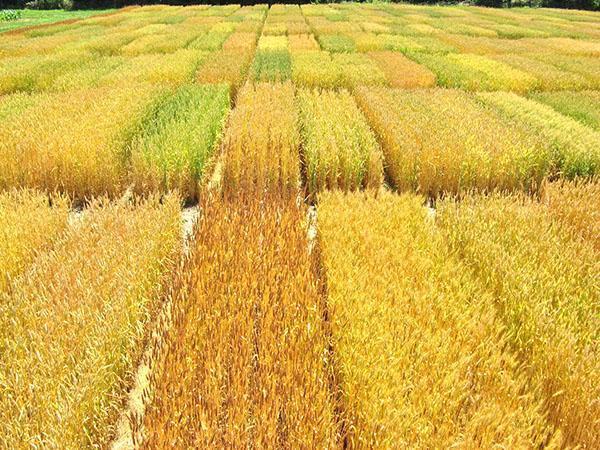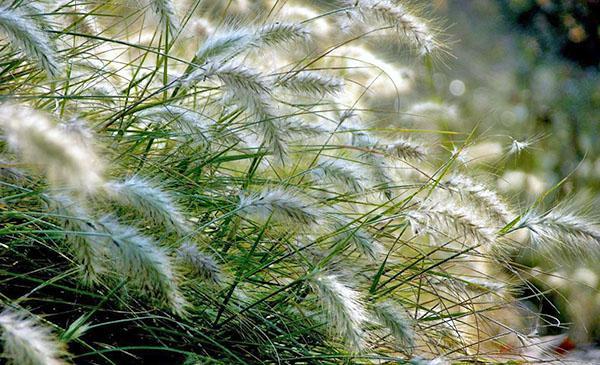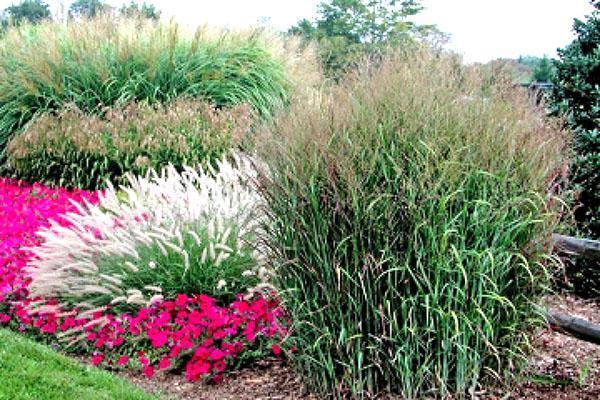Acquaintance with cereals
 Cereals are not only well-known agricultural crops. There are those that grow freely and are of no benefit to humans, as well as species that are used for design.
Cereals are not only well-known agricultural crops. There are those that grow freely and are of no benefit to humans, as well as species that are used for design.
Description of cereals and their importance for humans
The fruit of cereal plants is a monocotyledonous grain seed that has grown together with the shell. Leaves are long, with parallel venation, narrow, two rows. The stem is hollow, thin. Usually long. Inflorescences are paniculate, spikelet or racemose.

Cultivated cereals
Over time, people realized that not all cereals are edible and suitable for cooking. They were looking only for those whose grains made delicious food. That is, it was precisely cultivated cereals that were needed. Also, the person realized that it is not necessary to collect something somewhere.
Look for suitable plants, walk each time and find out: where they grow and in what quantity. Then take the seeds, carry them home and so on in a circle. After all, you can start growing cereal plants near your own home. Plant the fruits, water and wait for them to sprout, plants will grow out of them and ripen.
New fruits were harvested, some were left to grind, and some for the next sowing. This is how agriculture developed. New varieties of cereals were developed, which must be resistant to droughts and other negative influences. The breeders took into account the formula of the flower of cereals, in order to predict the genetic structure of new plants, to draw up a similar formula.
The altered individuals were subjected to careful research. The main goal of breeders is to create perfect varieties. These plants must be absolutely resistant to drought, weeds and other adverse influences. Each variety has its own name.
List of cultivated, weeds and herbaceous plants

Bluegrass are subdivided into three main categories: grains, weeds, and grasses. Some of the same types are used for decoration.
Not all representatives are represented in the lists, but several well-known cultivated, weed and herbaceous species. In fact, there are many more.
Cereals:
- common millet;
- oats;
- barley;
- corn;
- rice;
- rye;
- wheat.
Weed:
- creeping wheatgrass;
- chicken millet;
- rye fire;
- humay;
- multicolored chaff;
- annual bluegrass.
Herbs:
- quaking grass;
- pearl barley;
- feather grass;
- spikelet;
- lightning.
You should not call all grasses weeds that grow freely in meadows. They are the main food for livestock and poultry.
Photos and names of cereals
Cultivated cereals are specially grown for use as a food product. In writing I use whole and crushed grains, flour and pastries from it.
Millet
 Millet is a plant that tolerates heat and drought well. Common millet is valuable, it is from its seeds that millet is extracted. Homeland - Southeast Asia. It is grown everywhere, including on saline soils. High acidity is the only weakness of millet, it cannot stand it and dies. The grains are used for making cereals, soups, and also as feed for poultry.
Millet is a plant that tolerates heat and drought well. Common millet is valuable, it is from its seeds that millet is extracted. Homeland - Southeast Asia. It is grown everywhere, including on saline soils. High acidity is the only weakness of millet, it cannot stand it and dies. The grains are used for making cereals, soups, and also as feed for poultry.
Oats
 An annual plant that is widely used in agriculture. It is resistant to negative environmental conditions, it can be grown on those lands where it is cold enough. Originally from some provinces of East China, Mongolia. Previously, it was perceived by farmers as a weed, but its fodder properties refuted this opinion. Later they learned to make various pastries from it, and the Germans brewed the so-called white beer. It can be filmy and naked. The latter is less common than the former and requires a lot of moisture.
An annual plant that is widely used in agriculture. It is resistant to negative environmental conditions, it can be grown on those lands where it is cold enough. Originally from some provinces of East China, Mongolia. Previously, it was perceived by farmers as a weed, but its fodder properties refuted this opinion. Later they learned to make various pastries from it, and the Germans brewed the so-called white beer. It can be filmy and naked. The latter is less common than the former and requires a lot of moisture.
Barley
 One of the most important cereal crops, developed relatively recently, about seventeen thousand years ago. The inhabitants of the Middle East were among the first to notice about its benefits. Bread made from barley flour is heavier, rougher than wheat, but it is considered a healthier product even now. The plant is one-flowered, pollinated independently. Nowadays, barley is grown for both feed and food needs. Barley beer is also common among connoisseurs of this product.
One of the most important cereal crops, developed relatively recently, about seventeen thousand years ago. The inhabitants of the Middle East were among the first to notice about its benefits. Bread made from barley flour is heavier, rougher than wheat, but it is considered a healthier product even now. The plant is one-flowered, pollinated independently. Nowadays, barley is grown for both feed and food needs. Barley beer is also common among connoisseurs of this product.
Corn
 Also called maize or sweet corn. It is used for feed and food needs. Of the entire genus, this is the only representative of cultivated cereals. It differs from other species of the entire family by a large ear with yellow seeds. Country of origin - Mexico.
Also called maize or sweet corn. It is used for feed and food needs. Of the entire genus, this is the only representative of cultivated cereals. It differs from other species of the entire family by a large ear with yellow seeds. Country of origin - Mexico.
In terms of sales, it is in second place after wheat. Used to make cornstarch, canned food, and even medicines.
Rice
 An annual herb. Requires special attention, the plant is capricious, needs a lot of moisture. Grown in Asian countries, but some types of rice - in African countries. Rice fields are made so that they can be flooded with water (protection from sunlight) while the plant is ripe, but then drained to harvest. They make cereals, starch from grains. If the kernels are germinal, then they are great for making rice oil.
An annual herb. Requires special attention, the plant is capricious, needs a lot of moisture. Grown in Asian countries, but some types of rice - in African countries. Rice fields are made so that they can be flooded with water (protection from sunlight) while the plant is ripe, but then drained to harvest. They make cereals, starch from grains. If the kernels are germinal, then they are great for making rice oil.
Alcohol and medicines are made from rice. Rice straw is used to make paper, and the husk is used to make feed bran.
Rye
 Nowadays, winter rye is mainly used for sowing, since it is more resistant to adverse conditions. An unpretentious plant, unlike wheat, rye is not particularly sensitive to soil acidity. The best soil for growing is black soil. It is used for the production of flour, kvass and starch. Weed grass rye easily suppresses, which greatly facilitates the fight against harmful factors for cultivation. The plant is biennial and annual. Most popular in Germany.
Nowadays, winter rye is mainly used for sowing, since it is more resistant to adverse conditions. An unpretentious plant, unlike wheat, rye is not particularly sensitive to soil acidity. The best soil for growing is black soil. It is used for the production of flour, kvass and starch. Weed grass rye easily suppresses, which greatly facilitates the fight against harmful factors for cultivation. The plant is biennial and annual. Most popular in Germany.
Wheat
 In the first place in terms of cultivation and sale is this grain crop. Bread of the highest grade is baked from wheat flour, confectionery and pasta are produced. Wheat is also used in the production of beer and other alcoholic beverages. It is grown on almost all lands, except for territories belonging to the tropical zone. Includes about ten types.
In the first place in terms of cultivation and sale is this grain crop. Bread of the highest grade is baked from wheat flour, confectionery and pasta are produced. Wheat is also used in the production of beer and other alcoholic beverages. It is grown on almost all lands, except for territories belonging to the tropical zone. Includes about ten types.
Many people believe that yellow spikelets with long mustaches are wheat. However, it is not. Wheat has grayish spikelets, fewer grains, and short whiskers.
Photos and names of weeds
A person has to fight against weeds. Many of these plants are used as animal feed.
Creeping wheatgrass
 Easily displaces cultivated plants. It is very tenacious, capable of drawing juices from the ground that are needed by other species. The roots are powerful, more powerful than those of cultural representatives.Feels very good on moist fertile soil.
Easily displaces cultivated plants. It is very tenacious, capable of drawing juices from the ground that are needed by other species. The roots are powerful, more powerful than those of cultural representatives.Feels very good on moist fertile soil.
Chicken millet
 Chicken millet or barnyard. It bears this name due to the fact that this plant is very similar to its cultivated relatives. It is distinguished by its large size and large leaves, which require a lot of nutrients. Naturally, it is forced to rob other plants and take everything for itself.
Chicken millet or barnyard. It bears this name due to the fact that this plant is very similar to its cultivated relatives. It is distinguished by its large size and large leaves, which require a lot of nutrients. Naturally, it is forced to rob other plants and take everything for itself.
Rosichka
 The dewdrop, especially the blood red, has the same ability to survive as other weeds. May exist on acidic soils. It has a lot of seeds in its paniculate spikelets. For them to germinate, only two degrees of heat is enough.
The dewdrop, especially the blood red, has the same ability to survive as other weeds. May exist on acidic soils. It has a lot of seeds in its paniculate spikelets. For them to germinate, only two degrees of heat is enough.
Rye bonfire
 It can be easily confused with rye, but the survival rate is slightly higher. Drought-resistant. Inhabits rye fields. When its seeds are mixed with the seeds of a cultivated relative at harvest, the quality of the crop is reduced.
It can be easily confused with rye, but the survival rate is slightly higher. Drought-resistant. Inhabits rye fields. When its seeds are mixed with the seeds of a cultivated relative at harvest, the quality of the crop is reduced.
Gumay
 It also has a different name - Alepskoe sorghum. It is one of the most dangerous plants and poses a serious threat to cereal crops. It survives well during droughts, but despite this, sorghum is very demanding on moist and fertile soil. Has a powerful rhizome for constant nutrient intake.
It also has a different name - Alepskoe sorghum. It is one of the most dangerous plants and poses a serious threat to cereal crops. It survives well during droughts, but despite this, sorghum is very demanding on moist and fertile soil. Has a powerful rhizome for constant nutrient intake.
Spit multicolor
 It affects legumes and cereals. The chaff is widespread everywhere. Survives well in adverse conditions. The plant is sturdy, can reach one meter in height. Prefers nitrogenous soils.
It affects legumes and cereals. The chaff is widespread everywhere. Survives well in adverse conditions. The plant is sturdy, can reach one meter in height. Prefers nitrogenous soils.
Annual bluegrass
 Another representative of cereal weeds that harm agriculture. Grows in fields, mainly where grain crops are cultivated. Annual bluegrass is resistant to negative influences. This annual plant is widespread in Central Asia, Western Siberia, and also in the Caucasus.
Another representative of cereal weeds that harm agriculture. Grows in fields, mainly where grain crops are cultivated. Annual bluegrass is resistant to negative influences. This annual plant is widespread in Central Asia, Western Siberia, and also in the Caucasus.
Photos and names of cereal herbs
Grasses can become a decoration of our summer cottages if we learn how to use them correctly.
Quaking grass
 It grows mainly in the meadows of Europe. It resembles a bush with panicles of flattened spikelets. Loves sunlight and moderate moisture. Excellent as food for cattle and poultry.
It grows mainly in the meadows of Europe. It resembles a bush with panicles of flattened spikelets. Loves sunlight and moderate moisture. Excellent as food for cattle and poultry.
Pearl barley
 It is so called because its seeds are very similar to pearl barley. A perennial plant that grows in forests, sometimes in the steppes. It can often be found along the shores of lakes and swamps. Includes several varieties.
It is so called because its seeds are very similar to pearl barley. A perennial plant that grows in forests, sometimes in the steppes. It can often be found along the shores of lakes and swamps. Includes several varieties.
Feather grass
 Inhabits European steppes and meadows. It has a long thin spikelet resembling a light gray thread from a distance. Very well suited as feed for farm animals. He needs sunny, neutral soils. Pollinated independently.
Inhabits European steppes and meadows. It has a long thin spikelet resembling a light gray thread from a distance. Very well suited as feed for farm animals. He needs sunny, neutral soils. Pollinated independently.
Kolosnyak
 Grows in southern parts of Europe. It has a long root, as it grows in sandy soils. The plant is massive, with long thick spikelets. The color of the leaves is blue-green.
Grows in southern parts of Europe. It has a long root, as it grows in sandy soils. The plant is massive, with long thick spikelets. The color of the leaves is blue-green.
Molinia
 Large perennial plant. Found in forests, swamps, as well as along the banks of rivers and lakes. It looks like a bush with straight leaves. Spikelets are paniculate, large, dark purple in color. Grows in the European continent, in sunny areas or surfaces with moderate shade. It is often used as an ornamental plant.
Large perennial plant. Found in forests, swamps, as well as along the banks of rivers and lakes. It looks like a bush with straight leaves. Spikelets are paniculate, large, dark purple in color. Grows in the European continent, in sunny areas or surfaces with moderate shade. It is often used as an ornamental plant.